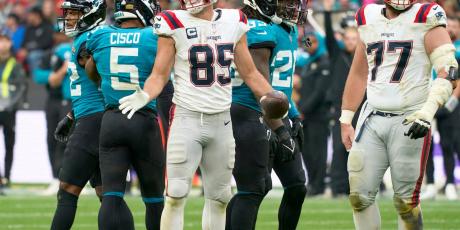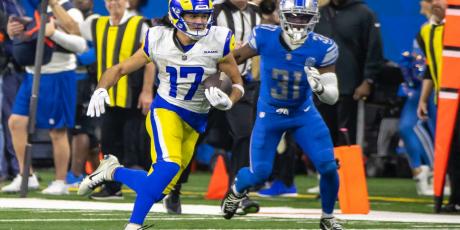2015 Fantasy Retrospective: Quarterbacks

Below is a table that provides a snapshot of the quarterback position in 2015.
Key columns to note…
FP: Fantasy Points
PPG: Points Per Game
Playoffs: Total FP in Weeks 14-16
RV: Relative Value (difference between that player’s points and the positional baseline, or QB12)
ADP: Round in which the player was drafted, on average
Positional ADP Rank: Rank at his position on draft day (e.g. Cam Newton was the #12 QB off the board)
| # | Player | Team | G | FP | PPG | Playoffs | RV | ADP | Pos ADP Rank | ADP Diff |
|---|---|---|---|---|---|---|---|---|---|---|
| 1 | Cam Newton | CAR | 16 | 389 | 24.3 | 78.9 | 107 | 8.8 | 12 | 11 |
| 2 | Tom Brady | NE | 16 | 344 | 21.5 | 47.8 | 61 | 6.7 | 8 | 6 |
| 3 | Russell Wilson | SEA | 16 | 336 | 21 | 78.4 | 54 | 4.4 | 4 | 1 |
| 4 | Blake Bortles | JAX | 16 | 314 | 19.6 | 77.2 | 32 | 15 | 25 | 21 |
| 5 | Carson Palmer | ARI | 16 | 309 | 19.3 | 52.3 | 27 | 12.9 | 19 | 14 |
| 6 | Drew Brees | NO | 15 | 304 | 20.3 | 75.4 | 22 | 4.8 | 5 | -1 |
| 7 | Aaron Rodgers | GB | 16 | 293 | 18.3 | 35.4 | 11 | 2.1 | 2 | -5 |
| 8 | Matthew Stafford | DET | 16 | 290 | 18.1 | 59.5 | 7 | 7.4 | 10 | 2 |
| 9 | Eli Manning | NYG | 16 | 290 | 18.1 | 58.9 | 7 | 9.2 | 14 | 5 |
| 10 | Kirk Cousins | WAS | 16 | 289 | 18.1 | 87.4 | 7 | 17.3 | 30 | 20 |
| 11 | Ryan Fitzpatrick | NYJ | 16 | 285 | 17.8 | 63.2 | 3 | 17.3 | 29 | 18 |
| 12 | Philip Rivers | SD | 16 | 283 | 17.7 | 44.4 | 0 | 9.7 | 15 | 3 |
| 13 | Jameis Winston | TB | 16 | 273 | 17.1 | 51.5 | -9 | 13.7 | 20 | 7 |
| 14 | Derek Carr | OAK | 16 | 271 | 17 | 45.4 | -11 | 14.2 | 24 | 10 |
| 15 | Tyrod Taylor | BUF | 14 | 269 | 19.2 | 55.2 | -14 | 16.2 | 28 | 13 |
| 16 | Alex Smith | KC | 16 | 267 | 16.7 | 42.5 | -15 | 15.2 | 27 | 11 |
| 17 | Ryan Tannehill | MIA | 16 | 257 | 16.1 | 44.8 | -25 | 8.2 | 11 | -6 |
| 18 | Andy Dalton | CIN | 13 | 244 | 18.8 | 0.4 | -38 | 14.2 | 23 | 5 |
| 19 | Matt Ryan | ATL | 16 | 232 | 14.5 | 31 | -51 | 6.3 | 7 | -12 |
| 20 | Jay Cutler | CHI | 15 | 225 | 15 | 44.7 | -58 | 14 | 22 | 2 |
| 21 | Ben Roethlisberger | PIT | 12 | 212 | 17.7 | 37.4 | -70 | 5 | 6 | -15 |
| 22 | Marcus Mariota | TEN | 12 | 206 | 17.2 | 20.7 | -77 | 13.8 | 21 | -1 |
| 23 | Teddy Bridgewater | MIN | 16 | 198 | 12.4 | 60.5 | -84 | 11 | 16 | -7 |
| 24 | Sam Bradford | PHI | 14 | 195 | 13.9 | 46.6 | -88 | 9.1 | 13 | -11 |
| 25 | Brian Hoyer | HOU | 11 | 167 | 15.1 | 4.1 | -116 | 18.1 | 32 | 7 |
| 26 | Joe Flacco | BAL | 10 | 160 | 16 | 0 | -123 | 12.4 | 17 | -9 |
| 27 | Blaine Gabbert | SF | 8 | 130 | 16.2 | 40.4 | -153 | - | - | - |
| 28 | Andrew Luck | IND | 7 | 129 | 18.4 | 0 | -154 | 1.8 | 1 | -27 |
| 29 | Josh McCown | CLE | 8 | 128 | 16 | 0 | -154 | - | - | - |
| 30 | Brock Osweiler | DEN | 8 | 119 | 14.8 | 59.5 | -164 | - | - | - |
| 31 | Colin Kaepernick | SF | 9 | 108 | 12 | 0 | -174 | 12.8 | 18 | -13 |
| 32 | Johnny Manziel | CLE | 9 | 95 | 10.6 | 38.6 | -188 | 19.6 | 33 | 1 |
| 33 | Nick Foles | STL | 11 | 94 | 8.6 | 0 | -188 | 15.1 | 26 | -7 |
| 34 | Peyton Manning | DEN | 10 | 91 | 9.1 | 0 | -191 | 4.1 | 3 | -31 |
| 35 | Matt Hasselbeck | IND | 8 | 91 | 11.4 | 21.1 | -191 | - | - | - |
| 36 | Ryan Mallett | HOU | 8 | 69 | 8.6 | 15 | -214 | - | - | - |
| 37 | Brandon Weeden | DAL | 6 | 67 | 11.1 | 29.9 | -216 | - | - | - |
| 38 | Matt Cassel | BUF | 10 | 65 | 6.5 | 2.7 | -218 | - | - | - |
| 39 | AJ McCarron | CIN | 7 | 55 | 7.9 | 40 | -227 | - | - | - |
| 40 | Zach Mettenberger | TEN | 7 | 44 | 6.3 | 25.6 | -238 | - | - | - |
Heading into the season, I was advocating a wait on QB strategy since the position continues to be as deep as it’s ever been. It worked in 2014 when I targeted (and landed) Russell Wilson in every league that mattered.
This year, my primary tactic was the Angry Tom Strategy (i.e. drafting Tom Brady and Carson Palmer to back him up during his suspension) or, if I missed out on Brady (which happened often), simply to draft Palmer in the 12th round as my QB1. I also ended up with Eli Manning in a few leagues since I felt that he was undervalued as the #14 QB off the board.
Needless to say, these strategies worked from a value standpoint. Brady finished as the #2 QB, while Palmer finished #5 and Manning at #9. None of these players were particularly good in the fantasy playoffs, however, but they all outscored Aaron Rodgers over that span, so that’s something.
Speaking of Olivia Munn's boyfriend, he had his worst year in quite a while and still finished as the #7 QB. He fared better than Andrew Luck (injured, #28) and Peyton Manning (injured, #34), who were the other two passers drafted in the Top 3. The only early-round quarterbacks to return value were Russell Wilson and Drew Brees, drafted #4 and #5 and finishing #3 and #6, respectively, though their performance still doesn’t justify drafting a QB early when there are so many values to be had later on.
Clearly, the best value play was to draft Cam Newton in the 8th or 9th round, but few of us saw this MVP-caliber season coming. Think about it – his PPG had decreased in each of his first four seasons, he finished #7 in 2014 and lost his best receiver, Kelvin Benjamin, before Week 1. Not only did he begin to throw touchdowns at an elite level (his TD% of 7.1% blew away his career high), he also ran the ball more than he ever has (132 rushes for 636 yards and 10 touchdowns).
Another standout value was Blake Bortles, who was available in the 14th/15th round yet finished as the QB4 on the season. He took major steps forward in his second year, at least from a fantasy perspective. He averaged 2.19 TD per game, which nearly tripled his 0.79 TD per game average in his rookie season. His passing yardage also increased from 208 to 277 yards per game, while his rushing numbers decreased from 30 yards per game in 2014 to 19 yards per game this season. He also ran for two scores, which allowed him to finish #4 instead of #6 at his position.
Even if owners didn’t land one of the aforementioned values at quarterback, there was ample opportunity to “end up with” a Top 18 quarterback. Kirk Cousins, Ryan Fitzpatrick, Jameis Winston, Derek Carr, Tyrod Taylor, Alex Smith and Andy Dalton were all drafted in the 13th round or later and finished in the #10-#18 range. Dalton had the lowest finish (#18), but he was on pace to finish #5 before suffering a hand injury.
The Bottom Line
Nothing that happened in 2015 is going to convince me to alter my quarterback strategy heading into next season. I will continue to look for passers being drafted in the 8th round or later who seem to be good values relative to the quarterbacks being drafted ahead of them. It worked in 2014 with Wilson and again last year with Palmer. Even if I hitch my wagon to the wrong horse there is ample opportunity to shift gears as other players emerge.






















